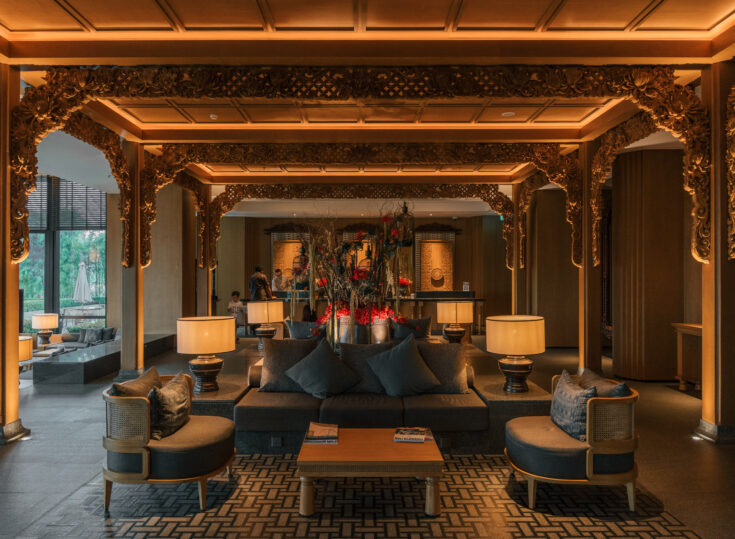In mesmerising and rhythmic movement, objects ripple, roll through sand, and glide down from the ceiling at Nirmana Kinetic Space in Melawai, a newly opened gallery tucked underneath the upscale East Asian restaurant SU MA and its accompanying cocktail haunt, SHŌ Bar. Navigating the intersection of art and technology, Nirmana has its gaze set on kinetic art, where every piece is a culmination of design ideas and engineering precision working together in synchronicity.
“To me, motion is one of the most primal languages—even before words. That’s why kinetic art feels alive. It doesn’t just wait to be looked at; it invites a relationship. There’s something deeply human about watching a physical object move by design,” shared co-founder Adi Panuntun, who plays an influential role in the creative direction of the exhibited artworks—all of which, at the moment, were designed and engineered by Nirmana’s in-house team.
First initiated in 2020, Nirmana made a mainstream breakthrough in 2022 during the Head in The Clouds concert in Pantai Indah Kapuk, collaborating with Bandung-based studio Sembilan Matahari—also co-founded by Adi—to create an experiential zone for the concert-goers. There, Nirmana’s kinetic pieces merged with Sembilan Matahari’s eye for artistic applications of digital technology, which saw installations such as ‘Pixel Wall’, a wall of light that captured passing people and rendered them into a 2-bit image of themselves, and a rotating wall piece in ‘Cycloops’ that formed ever-changing patterns with each loop.
Now, the newly opened gallery marks yet another significant milestone for the project, with more spaces dedicated to exhibiting Nirmana’s kinetic art pieces already in the works. “This space is the beating heart of our experiments [with the medium]. It’s where we can fail, try again, and share what we discover with the public.”
It kicks off with seven installations spread across six different rooms that flow into one another—some dark and quiet, others vivid with music and movements—forming a circular path that visitors can explore independently after an introductory tour, which allows time and space for them to take it all in as they watch each motion unfold.
Placed at the very beginning in the ‘induction’ room, ‘Saujana’ immediately sets the tone, teasing a glimpse of the technological marvel that is at work behind these installations. Within the coffee table contraption, a magnetic ball courses its own path through fine sand, a design inspired by American artist Bruce Shapiro’s ‘Sisyphus’. And like the Greek mythical figure, the ball in ‘Saujana’ toils endlessly, forming intricate pictures across the sand’s surface, only to restart and begin an entirely new cycle to create a total of 125 programmed patterns.
Deeper in, ‘Amerta’ signifies a different sense of perpetuity with its durable stainless steel body. The massive wing-shaped installation spreads across the courtyard, its oscillating, fragmented parts stark under the city’s starless skies—like a picture of a mecha bird that finds itself rooted to the ground. But its shadow on the wall behind it tells a different story; projected against a backdrop of rippling water, Amerta transforms into an image of a black manta ray, freely swimming its way through the ocean.
Other kinetic pieces appeal with their interactivity. Inspired by the movement of water, the bench-shaped ‘Bena’ invites visitors to ‘ride the wave’ and sit upon its undulating surface, turning the kinetic art into functional design. While in ‘Senandika’, visitors can ‘choreograph’ the 240 synchronised wooden blocks, reshaping the wall and making it form personalised patterns and words.
Speaking on a shared element that binds these creations together, Adi conveyed that Nirmana is “drawn to works that feel honest—technically simple, but emotionally resonant.” And rather than a unifying ‘style’, they each similarly draw from “the graceful and calming motion of nature.”
Just as the sight of crashing waves or a shower of fallen leaves can offer a sense of ease, Nirmana’s pieces send off an encouragement to sit and be still with one’s emotions, allowing the movement of the machinery to be the only motion in the room, made all the more pronounced by the atmospheric music that progresses along the same rhythm as the objects.
“Kinetic art anchors us in the present—to tactility, to the here and now,” mused Adi. “In a time when everything is becoming virtual, movement in physical space becomes even more meaningful.”

























